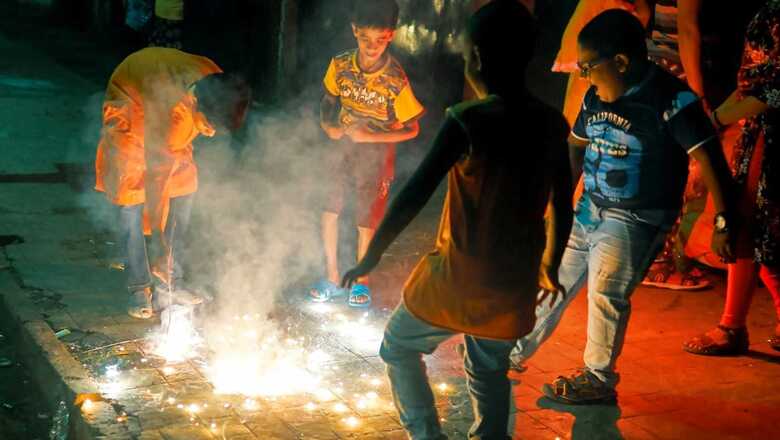
views
With air quality deteriorating across the National Capital Region (NCR), an early winter pollution alert issued by the Centre for Science and Environment (CSE) has warned that conditions are turning ripe for a severe smog episode to begin from Diwali night.
The festival is falling relatively early this year when the days are still warmer, and prevailing winds could help dilute the pollution during the day. The farm fires are also relatively less, and yet to overwhelm the air quality. However, CSE’s analysis based on previous years’ data shows that Diwali night can add 300-600 µg/m3 of PM2.5 to Delhi’s air if the business-as-usual scenario continues. Just a day before, the Commission for Air Quality Management (CAQM) too had warned of the start of poor air days for Delhi from October 22, with a subsequent rise in pollutants.
While the impact of stubble burning on air quality remains low due to a 50 per cent drop in fire counts in this season so far, CSE says the “low number implies that massive burning is in store in the coming few days”. According to the researchers, there is a “very high” likelihood that farm stubble fire will drastically increase during the days leading to Diwali and will continue post the festival. Delay in the start of the burning season in the past has resulted in a concentration of burning activities which intensifies the smoke-fall in the region, they added. However, it remains to be seen what will happen this year.
Longer, More Intense Smog Episodes
One of the most worrisome trends to emerge from the analysis is the increase in the duration as well as the intensity of smog episodes over the years. As per Delhi’s Graded Response Action Plan (GRAP), a smog episode is declared when the levels of PM2.5 remain in the “severe” category for three consecutive days.
The analysis showed that there were three distinct smog episodes during the 2021 winter lasting for a total of 20 smog days, which was more than the 2020 winter which had 14 smog days, and even the 2019 winter which had 19 smog days. “Most smog days were observed in the 2018 winter when four smog episodes were recorded with a total of 31 smog days,” it stated.
2022 Monsoon Season Cleanest In Last 8 Years
One hope was that Delhi had the cleanest start to winters since wide-scale monitoring started in 2018. In fact, the 2022 monsoon season was found to be the cleanest (in terms of air quality). The national capital received an unprecedented 115 mm of rainfall in the first two weeks of October, which pushed the usual state of bad air quality days further. There were five “good” AQI days (for PM2.5) in the first two weeks of October — the most recorded in the last eight winter seasons — compared to mere two “good” AQI days in the 2021 winter season.
Its effects started to wane as PM2.5 levels rose above 90 µg/m3 (“poor” AQI breakpoint) on October 16. However, it remains to be seen if the seasonal average of PM2.5 during winter — that had improved during the pandemic but stagnated post-pandemic — will further bend or increase, said the assessment.
“The intensity of winter pollution and severity of smog episodes will depend on the effectiveness of the long-term, multi-sector action so far in the entire region of Delhi and NCR and also on the enforceability of the short-term emergency action. Only the effectiveness of the air pollution control measures targeting all key sources will determine if the winter pollution trend that had stabilised post pandemic will continue to hold and improve or worsen further,” said CSE executive director (research & advocacy) Anumita Roychowdhury.
Brace For Diwali
Despite the ban, firecrackers are usually burnt across Delhi-National Capital Region triggering a massive spike in pollutants, which is persistently on the rise. The PM2.5 concentrations on Diwali night (8pm to 8am) last year stood at 747 µg/m3, 22 per cent higher than that in the 2020 Diwali night. The levels on 2021 Diwali night were 4.5 times the average night-time levels recorded in the week preceding Diwali.
According to the analysis, hourly concentrations can go beyond 1,000 µg/m3. On the Diwali of 2021, 26 of 38 operational monitoring stations hit the 1,000 µg/m3 mark. In 2020, 23 of 38 stations had hit the 1,000 µg/m3 mark, while in 2019 the number stood at 22 stations, as per the analysis done by CSE’s Urban Lab, which studied the annual and seasonal trends in PM2.5 concentrations in winters and pre-winters for the last seven years in Delhi and the National Capital Region, starting 2015.
According to Roychowdhury, it is a wake-up call for more stringent pre-emptive and preventive measures to avert the smog episodes that cause excessive exposure and health risk during winter. The enforcement of GRAP needs to be equally stringent with zero tolerance across Delhi and NCR.
GRAP suggests strict action to prevent industrial or household waste burning, access to clean fuels, LPG and electricity to all eateries and households, strengthening of public transport, dust control and minimising the use of diesel generator sets.
Read all the Latest News India and Breaking News here
















Comments
0 comment